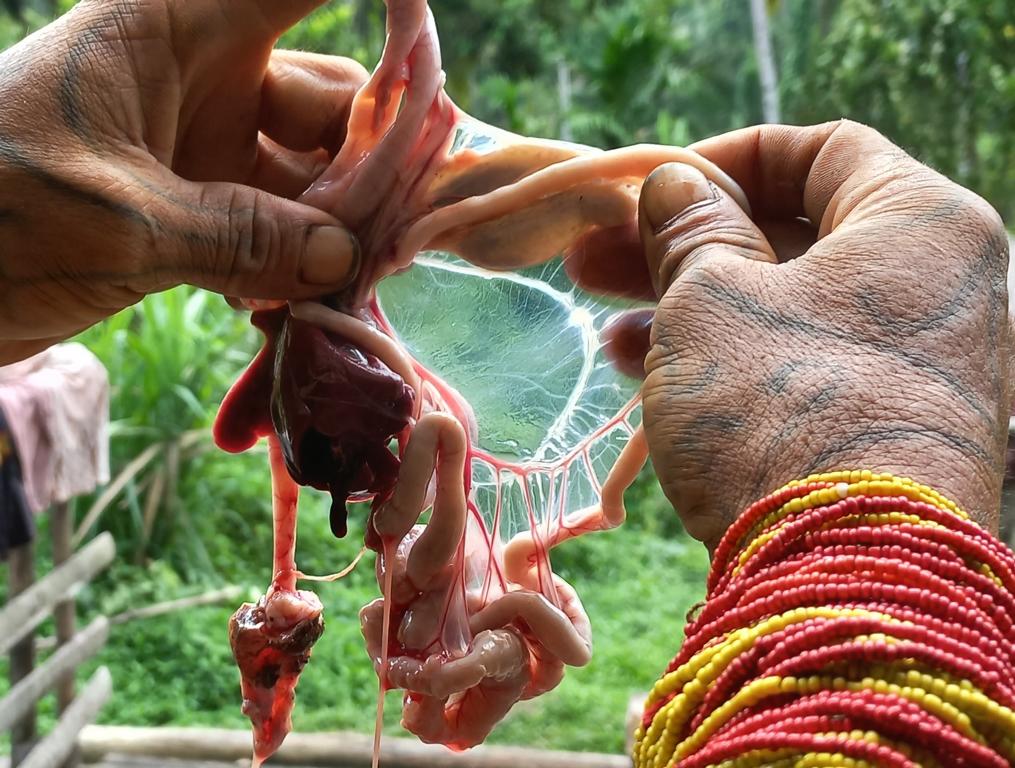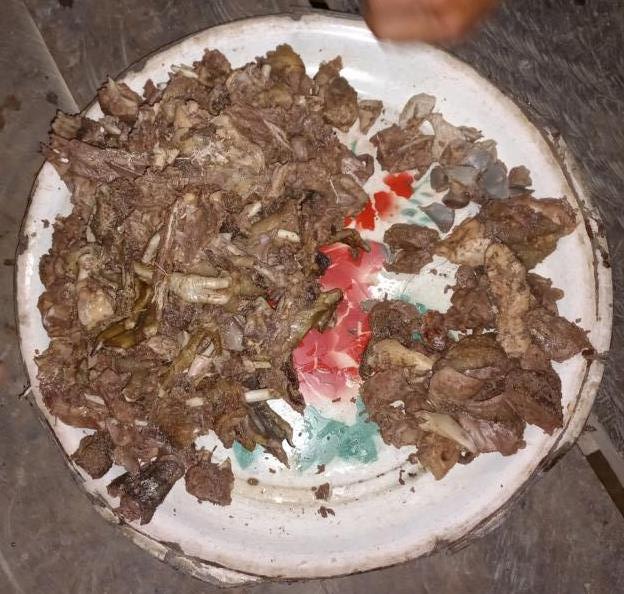Domestic chickens are omnipresent around every Uma (family home) in the forests of Siberut Island. During nighttime, they are kept in closed coops to protect them from predators like civet cats. While staying with Mentawais, I observed no nesting boxes or Mentawais using eggs, but many mother hens had chicks. Domestic chickens are only slaughtered and eaten for family gatherings, ceremonies, and as gifts. Such gifts are either for shamanic support or for family members returning home.

Catching domestic chicken

Catching domestic chicken is not an easy feat. They are fast and intelligent. Catching them with a hooked stick, as is the case in other cultures, would be too obvious. They would disappear in this unfenced area immediately. Instead, Mentawais are using split rattan lianas of Calamus javensis. That is the same material they are also using for assembling palm roof panels.
After deciding which animal to catch, a convenient area will be baited with rice bran. Afterward, a snare with an opening diameter of about 20cm/8’’ and a 3m long handle will be set on this feeding place. When the targeted chicken steps into the snare, the catcher pulls onto the handle, and the chicken is held securely by its foot or feet.
Shamanic ceremony
Before slaughtering the chicken, its spirits will be requested for forgiveness. The shaman tells the spirits that killing the chicken is not done for fun or other lowly interests but is necessary to convey to the spirits that people expect something in return for their sacrifice from the spirits. And the soul of the sacrificial animal is promised an honorable abode in the Uma. He also tells them how highly he is regarding this chicken and rubs it onto the Uma floor. Sometimes, he even goes around and touches all persons present with the chicken. After appeasing the spirits, the shaman spits onto the chicken, its death spell. Then, the shaman is no longer interested in the chicken and hands it to a helper.
Slaughtering domestic chicken
Immediately after handing over the chicken, the helper breaks its neck with one fast grip. A bunch of wing feathers will be pulled out and stuck between the palm panels of the Uma roof. The remaining chicken—with all feathers on—will be brought to one of the fireplaces. All feathers (and external parasites) will be burnt and singed off there. After that, the carcass will be washed and brought to the shaman.
The shaman cuts open the carcass and extracts the small intestines. He is mainly interested in the condition of the serosa membrane, a thin, transparent layer of connecting tissue that also provides a protective covering for the intestines.

The serosa membrane’s ‘inner mirror’ must be free from blood knots or other unnatural disturbances, like in the picture above.

The shaman can tell from the connective tissue between the intestinal loops of the sacrificed chicken whether the spirits have accepted the sacrifice and whether they will give the people the expected return. The blood knot in the above picture was a distressing sign for the shaman, and there were lively discussions about whether the spirits accepted his request. But there was never a discussion about the chicken’s health status and whether it could be eaten.

Cooking chicken

After checking the future by the serosa membrane, the whole chicken will be cut into cubes of about 5x5cm/2’’x2’’. The meat will be boiled vigorously in a large cast iron pot with other meat, e.g., ducks, wild game, or other domestic chicken, and a handful of red ginger lily flowers.
The meat is divided equally among the various eating groups the same way, as discussed earlier in my article about sago sticks. As described in that article, sago sticks are the primary side of the meal.
Lessons learned about the processing of domestic chicken by Mentawais:
- Domestic chickens are a source of protein for festivities and ceremonies.
- They are also used as gifts for shamanic services and to relatives.
- The chicken will be caught with rattan snares.
- Before a chicken is slaughtered, its spirits will be appeased.
- Checking the serosa membrane of the small intestines is a must before further cooking.
.




